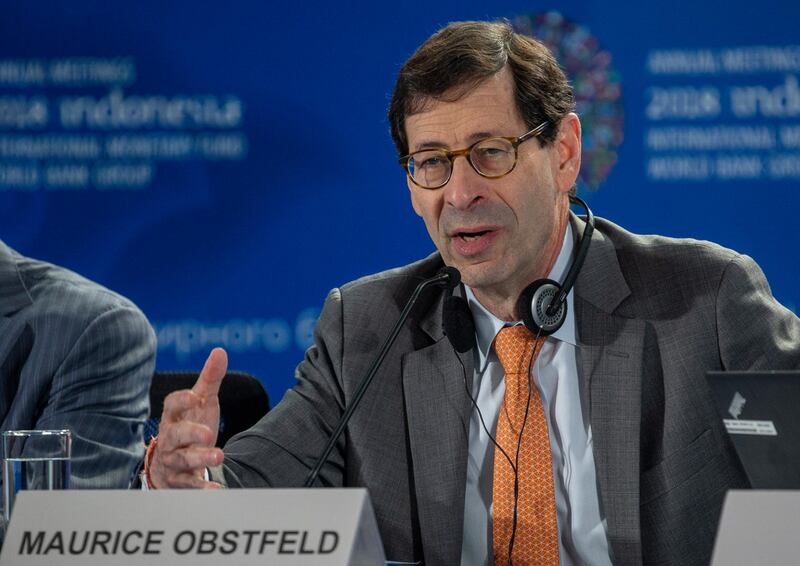The International Monetary Fund cut its global economic forecast for this year and next, the first downgrade since July 2016, due to strained trade ties, vulnerable emerging markets and sluggish growth in the eurozone, which is facing the uncertainty of Brexit and American protectionism.
The fund released a gloomy outlook on Tuesday as central bankers and officials gather at the annual IMF and World Bank meetings taking place in Bali. The global economy will now grow 3.7 per cent in 2018 and 2019, 0.2 percentage points lower than the fund’s July forecast, and at the same pace of 2017.
“Overall, world economic growth is still solid compared with earlier this decade, but it appears to have plateaued,” said Maurice Obstfeld, the funds’ economic counsellor.
Rising tensions and an escalating trade war between the United States and China, the world’s two largest economies, threatens global growth. The fund expects US economic expansion to peak at 2.9 per cent this year and start to slow down next year as the economic stimulus introduced in the wake of the 2008 global credit crisis begins to wind down and tariff impact begins to hurt.
In a simulation of the effect of rising barriers between the US and its trade partners, the fund forecasts global output would fall by more than 0.8 per cent in 2020. That largely hinges on China retaliating with 25 per cent of levies on $267 billion of US goods, taxes on car and trucks, and ebbing investor confidence. US output would decline by more than 0.8 per cent and China’s output would dip by more than 1.6 per cent next year as a result, according to the fund's projections.
____________
Read more:
[ IMF prepares to cut global economic outlook on escalating trade war ]
[ Trade barriers need reforms to temper tensions, IMF and World Bank say ]
____________
Global expansion is set to decelerate further to 3.6 per cent by 2022 to 2023 as a result of sluggish economic growth of advanced economies.
“Beyond the next couple of years, as output gaps close and monetary policy settings continue to normalise, growth in most advanced economies is expected to decline to potential rates - well below the averages reached before the global financial crisis of a decade ago,” the report said. “Slower expansion in working-age populations and projected lacklustre productivity gains are the prime drivers of lower medium-term growth rates
A strong US economy has also hastened an increase in interest rates. The gradual hikes by the US Federal Reserve has magnified fissures in vulnerable emerging market economies affecting countries like Argentina and Turkey, already grappling with existing economic woes.
“Compared with 10 years ago, many of these economies have higher levels of corporate and sovereign debt, leaving them more vulnerable,” said Mr Obstfeld. “With geopolitical tensions also relevant in several regions, we judge that, even for the near future, the possibility of unpleasant surprises outweighs the likelihood of unforeseen good news.”
Regionally the growth forecast for the Middle East and North Africa was lowered by 1.2 and 1.3 percentage points to 2 and 2.5 per cent for this year and 2019. The revised figures are partly because of a contraction in Iran on the back of US sanctions. Iran’s economy will shrink 1.5 per cent this year and 3.6 per cent in 2019 as oil production and exports plummet.
Saudi Arabia, the biggest Arab economy which contracted 0.9 per cent last year, will expand 2.2 and 2.4 per cent in 2018 and 2019, 0.3 and 0.5 percentage points higher than the July forecast. The brighter outlook is due to higher non-oil growth and an uptick in oil production as global crude output cuts that started in January last year, come to an end.
The UAE’s economy which grew 0.8 per cent last year, will expand 2.9 and 3.7 per cent in 2018 and 2019. The country has announced a series of economic measures aimed at propelling economic growth, including lowering the cost of doing business and offering 10-year residency to certain professions.
In Abu Dhabi, the biggest economy in the UAE, growth is expected to accelerate after the emirate revealed in June a Dh50 billion stimulus programme to be spent over three years and which will be accompanied by initiatives aimed at fostering private sector growth.






